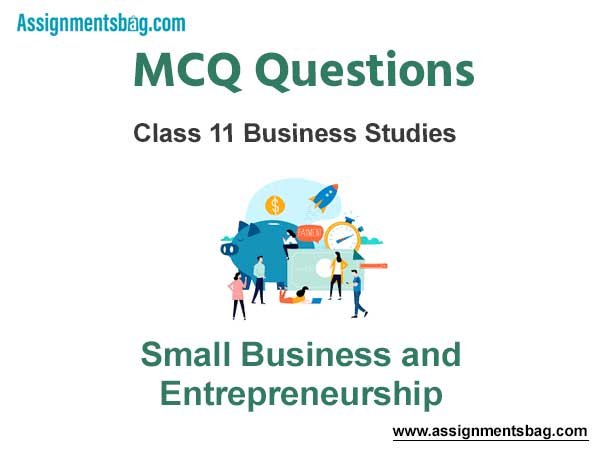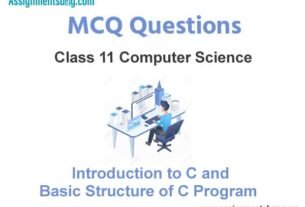Please refer to MCQ Questions Chapter 9 Small Business and Entrepreneurship Class 11 Business Studies with answers provided below. These multiple-choice questions have been developed based on the latest NCERT book for class 11 Business Studies issued for the current academic year. We have provided MCQ Questions for Class 11 Business Studies for all chapters on our website. Students should learn the objective based questions for Chapter 9 Small Business and Entrepreneurship in Class 11 Business Studies provided below to get more marks in exams.
Chapter 9 Small Business and Entrepreneurship MCQ Questions
Please refer to the following Chapter 9 Small Business and Entrepreneurship MCQ Questions Class 11 Business Studies with solutions for all important topics in the chapter.
MCQ Questions Answers for Chapter 9 Small Business and Entrepreneurship Class 11 Business Studies
Question. The District Industries Centers Programme was launched on
(a) On 15 August 1978
(b) On May 1, 1978
(c) On September 1, 1978
(d) On July 1, 1978
Answer
B
Question. ISO 9000 is concerned with
(a) Export
(b) Quantity
(c) Quality
(d) Import
Answer
C
Question. Small industries contribute _______ of gross industrial value.
(a) 49 percent
(b) 45 percent
(c) 48 percent
(d) 40 percent
Answer
D
Question. NSIC was setup in
(a) 1982
(b) 1975
(c) 1965
(d) 1955
Answer
D
Question. Small scale industries owned and managed by women entrepreneurs have a share capital of not less than __________
(a) 20 percent
(b) 51 percent
(c) 25 percent
(d) 50 percent
Answer
B
Question. Which of the following is part of the small-scale sector?
(a) Paper Products and Printing
(b) Food Products
(c) Cotton Textiles
(d) All of the above
Answer
D
Question. _____ is defined as one in which the investment in fixed assets of plant and machinery does not exceed rupees one crore.
(a) Small Scale Industry
(b) Limited Companies
(c) Large Scale industry
(d) None of the above
Answer
A
Question. Expand KVIC
(a) Khadi and Village Industries Commission
(b) Khadi and Village industries core
(c) King of Village Industries Commission
(d) King of Village Investment culture
Answer
A
Question. Which of the following is the main problem for small businesses?
(a) Raw material
(b) Finance
(c) Managerial skill
(d) All of the above
Answer
D
Question. Which of the following is organised by individuals?
(a) Cottage Industries
(b) Chemical industry
(c) Railway industry
(d) None of the above
Answer
A
Question. Limit of investment in small scale industry is _________
(a) One crore
(b) Ten crore
(c) Two crore
(d) Five crore
Answer
A
Question. Which industrial sector promotes small-scale business & entrepreneurship and has low barriers to market entry?
(a) Service
(b) Manufacturing
(c) Distribution
(d) Agriculture
Answer
A
Question. Which of the following comes under the Modern Small Industries?
(a) Coir
(b) Handicrafts
(c) Khadi
(d) Powerlooms
Answer
D
Question. The District Industries Centers Programme was launched on
(a) On 15 August 1978
(b) On May 1, 1978
(c) On September 1, 1978
(d) On July 1, 1978
Answer
B
Question. Which of the following is the main problem for small businesses?
(a) Raw material
(b) Finance
(c) Managerial skill
(d) All of the above
Answer
D
Question. In India which norm is not used for the measurement of business units :
(a) Number of person engaged in the business
(b) Capital investment in the business
(c) Quantity of production
(d) Number of educated people in the business
Answer
D
Question. An entrepreneur is:
(a) Born
(b) Made
(c) Bom and made both
(d) All of these
Answer
D
Question. TRIPS stands for _______.
(a) Trade Related Intellectual Property Services
(b) Trade Related Intellectual Property Sector
(c) Trade Related Intellectual Property Rights
(d) Trade Related intellectual Property Standards
Answer
C
Question. Investment limit in small business:
(a) 20 lakh
(b) 25 lakh
(c) 10 lakh
(d) 2 lakh.
Answer
B
Question. Trademarks help to:
(a) Determine the price of a product
(b) Differentiate the goods of one company from another
(c) Determine the manufacturing date of the product
(d) All of the above
Answer
B
Question. MSMEs contribute to______percent of GDP:
(a) 25
(b) 50
(c) 29.7
(d) 75
Answer
C
Question. Which of the following is organised by individuals?
(a) Cottage Industries
(b) Chemical industry
(c) Railway industry
(d) None of the above
Answer
A
Question. Which of the following is one way that freedom in a private enterprise system is limited by laws:
(a) Certain occupations must be licensed.
(b) All workers must take ability tests.
(c) Specific pay scales are regulated.
(d) Employees must register with the state.
Answer
A
Question. What type of promotional media is a business using when it sends out a postcard telling customers who recently purchased products that the business is adding a new line of products?
(a) Participative
(b) Sales letter
(c) Persuasive
(d) Direct mail
Answer
D
Question. The ski shop manager set an objective to increase sales by 10% over the previous year even though the forecast was for a mild and rainy winter. The manager’s objective was
(a) reasonable.
(b) practical.
(c) unrealistic.
(d) scientific.
Answer
C
Question. Which of the following employees would most likely be described as “innovative” by his/her supervisor:
(a) Jake, because he is always willing to adapt to changes during a project
(b) Madison, because she prefers to stick to traditional ideas and processes
(c) Elizabeth, because she gets frustrated when she needs to learn new skills
(d) Anthony, because he is usually quiet during brainstorming sessions
Answer
A
Question. Exemption from paying taxes for 5 ot 10 years is known as ______
(a) Tax Deduction
(b) TDS
(c) Value Added Tax
(d) Tax Holiday
Answer
D
Question. If a business considers where the consumers are and who they are before selecting a channel of distribution, the business is considering the __________ factor.
(a) human
(b) promotion
(c) market
(d) sales
Answer
C
Question. Which of the following is not considered as one of the following blocks of the model entrepreneur?
(a) Technical skills
(b) Managerial competencies
(c) Business competencies
(d) Personal attributes
Answer
C
Question. To determine their human resource needs, new business owners often find it helpful to
(a) list all the tasks involved in operating the business.
(b) ask a technical recruiter for advice.
(c) hire consultants or freelancers.
(d) allocate funds for additional payroll taxes.
Answer
A
Question. To develop repeat business and customer loyalty, a business owner might
(a) update equipment.
(b) increase prices.
(c) ridicule the competition.
(d) offer a new service.
Answer
D
Question. Modern small industries include
(a) Handloom
(b) Power loom
(c) sericulture
(d) Handicrafts
Answer
B
Question. The total contribution of raw material and machinery is Rs.10 lakh
(a) Micro enterprise
(b) small enterprise
(c) medium enterprise
(d) large enterprise
Answer
A
Question. Which of the nodal agency works for the Co ordination and development of village and Khadi Industries?
(a) Ministry of agro and rural industries
(b) Khadi and village industries
(c) National small industries corporation
(d) NABARD
Answer
A
Question. Khadi and village industries are identified as
(a) Large scale industries
(b) Traditional small scale industries
(c) Modern small scale industry
(d) Medium scale industry
Answer
B
Question. Agency works for the benefit of socially and economically disadvantaged groups and individuals
(a) RWE
(b) SFURTI
(c) RSBDC
(d) DIC
Answer
C
Question. What is the full form of IPR
(a) Intellectual property right
(b) Indian protection rights
(c) Indian private remuneration
(d) Intellectual private rights
Answer
A
Question. MSMED act came into existence
(a) October 2007
(b) October 2006
(c) October 1991
(d) October 2013
Answer
B
Question. National small industries corporation was set up in the year
(a) 1956
(b) 1955
(c) 1953
(d) 1954
Answer
B
Fill in the blanks:
Question. Full form of NSIC _________
Answer
national small industries corporation
Question. In manufacturing, micro enterprises investment in _________ Should not exceeed rs 25 lakh .
Answer
plant and machinery
Question. Small scale enterprise as defined in _________ act .
Answer
MSMED 2006
Question. NSIC has implemented a new scheme of _________ small business.
Answer
performance and credit rating
Question. Full form of DIC is _________ .
Answer
District industrial centre
Question. The MSMED Act came into force on_________ .
Answer
6 oct 06
True / False:
Question. Patent can only be files tpo get rights over an invention and not discovery.
Answer
True
Question. Trade secrets in India Is protected under the Indian Contract act ,1872
Answer
True
Question. The unique features of copy right is that the protection of work arises automatically as soon as work comes in to existence .
Answer
True
Question. The SFURTI was set up by the state government as well as Central Government.
Answer
False
Question. The rural Small business Development centre is Sponsored by RWED
Answer
False
Question. Copy right is granted for scientific inventions.
Answer
False
Match the following:
Question. Match their intellectual properties with tenure of protection provided:
| Column A | Column B |
| 1. Copyright | (a) 20 years |
| 2. Trademark | (b) author‟s life plus 70 more years |
| 3. Patent | (c) for as long as the mark is used in commerce |
Answer
1-b, 2-c, 3-a
Question. Match the intellectual properties with there products.
| Column A | Column B |
| 1. Copyright | (a) crocin |
| 2. Trademark | (b) CDs |
| 3. Patent | (c) Adidas |
Answer
1-b, 2-a, 3-c
Question.
| Institutions | Establishment year |
| 1. NSIC | (a) 1 May 1978 |
| 2. DIC | (b) 1955 |
| 3. MSMED ACT | (c) 1951 |
| 4. Development of regulation Act | (d) 2006 |
Answer
1-b, 2-a, 3-d, 4-c
Question.
| Institution | Objectives |
| 1. RWED | (a) To Develop Clusters of traditional industries in various parts of the country |
| 2. DIC | (b) To support the early phase of entrepreneurship development |
| 3. START UP SCHEME | (c) To Solve the Problems of industries reports , credit etc. |
| 4. SFURTI | (d) Providing training manuals for women entrepreneurship and training them |
Answer
1-d, 2-c, 3-b, 4-a
Question.
| Institution | Full Form |
| 1. NSIC | (a) Micro ,Small and Medium enterprises |
| 2. DIC | (b) National Small Industries corporation |
| 3. MSMED | (c) Rural and Women entrepreneurship Development |
| 4. RWED | (d) district Industries Centers |
Answer
1-b, 2-d, 3-a, 4-c

We hope you liked the above provided MCQ Questions Chapter 9 Small Business and Entrepreneurship Class 11 Business Studies with solutions. If you have any questions please ask us in the comments box below.

